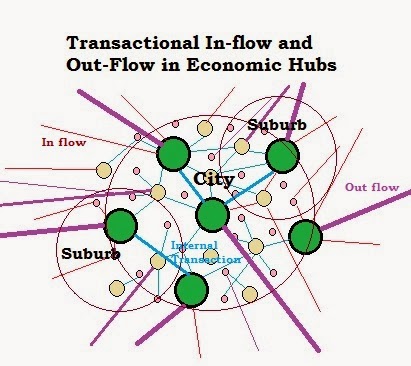The value of an economic hub is its ability to draw in new
resources and convert them to higher value products for exportation. The
economic value of a system can be seen as the total value of exports minus the
total value of imports. In other words, the cost of materials and production
input should be of lower value than the export of higher end value products.
Effective hubs create value by using their connections and resources in an
effective manner to generate sustainable financial resources.
Markets have large, medium and small businesses that
contribute to the development of strong hubs through the interaction of
resources, communication (business and social), and innovation that turns lower
value inputs into larger exports. The more effectively the business and social
community can work together the more the economic system can grow for the
benefit of all members.
In the diagram these transactions are noted in blue and may
be larger or smaller based upon the value of the business relationships and the
value of their transactions. When government runs efficiently and transparently
the transaction costs of conducting business within a particular hub decreases.
Where demographic and market information is easily accessible and transaction costs are
low businesses will naturally be inclined to invest further in these lower risk
markets.
Larger businesses often rely on medium and small business to
supply their needs as well as improve upon their capacities. For example, some
small businesses may take over functions outside of the core competencies of
the organization (i.e. maintenance) to help ensure strategic focus. Other businesses
may provide new innovative concepts that larger businesses adopt, develop and
export on a larger scale. Still others export in the niche market. Each relies on the other for success.
Investment within proper infrastructure can reduce this
costs by lowering taxes, increasing the speed of information transference, and furthering
the interaction of business entities for development. Each infrastructure project should have
goals and objectives to improve upon the social and business platform to spur
greater economic growth. As activities and investment increases
so will the life quality of the inhabitants. They will find improved services,
employment opportunities, and greater options for personal advancement.
Imports of materials, information, and knowledge denoted in
red should be of lower value than the export of finished products and services
denoted in purple. The value creation of the hub is based upon on how
businesses and individuals use these resources to develop higher value products
for exportation. Individuals invest their time and energy and companies invest
their financial resources to develop better products and more opportunities. Labor, Management, and Investors have an inherent stake to produce value.
Cities are generally the center of suburbs and are part of
the same hub. In the global economy it is the larger macroeconomics of an area
that takes precedence. The business, civic, and social connections will
determine how effectively they can work together to solve problems and become
economic viable. Some businesses will be located within the suburbs and others
within the city but each is connected together through social and business
connections that help ensure mutual self-interest in development. When they do not produce value or cannot create synergy they are considered dysfunctional. Constructive connections and financial interaction
often leads to higher levels of economic activity for members.

No comments:
Post a Comment